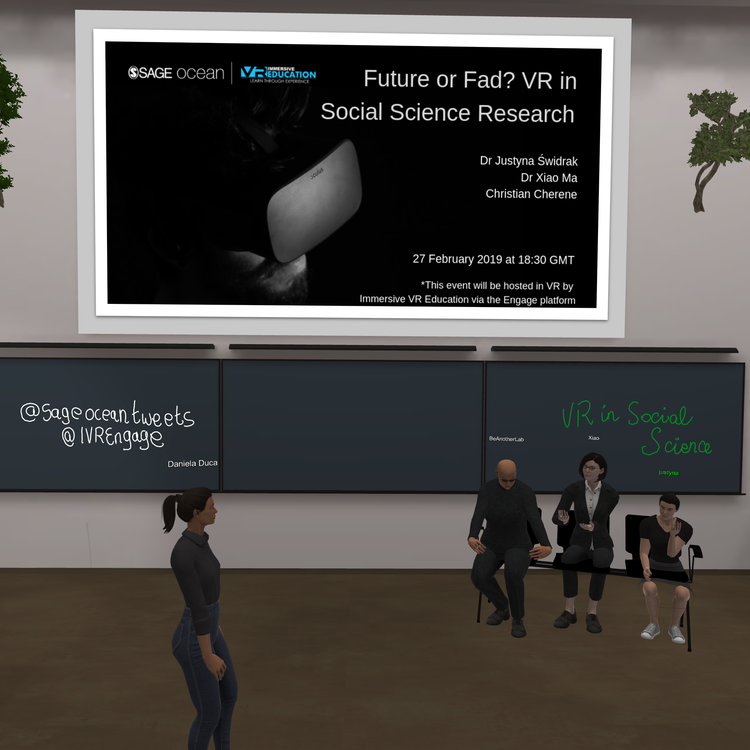VR in Social Science Research: Future or Fad?

At the end of February we ran a most enthralling event experience. Three panelists, two hosts and about 20 attendees all put their headsets on from their labs, offices and homes to join a virtual classroom decorated with trees, a castle, a slightly scary tiger and a hippo, to talk about the future of VR in social science research.
After a few minutes of getting comfortable in the virtual auditorium and fiddling with our virtual tablets (the speakers loading up their presentations while the rest of us took selfies) we were ready to go. Chris Long from the VR platform Engage opened with some notes on logistics – no fire alarms there. I (Daniela) introduced the SAGE Ocean initiative before handing over to the speakers to talk about their experience with VR.
Dr Justyna Świdrak spoke about her latest research project in VR. She and her team studied the Midas effect – the phenomenon that people are more likely to do something for you if you briefly touch their arm. Surprisingly for some, having another avatar touching your avatar in VR produces similar responses to being touched in real life. Justyna looked at how the responses differed between Polish and Spanish men, one being a more touch-friendly culture than the other.

Dr Xiao Ma and her team at Cornell University took a big risk when they recruited participants via Amazon’s Mechanical Turk for reproducing one of Milgram’s studies in VR. More than 100 people had the right gear and participated, sometimes even concomitantly, which meant no need to bring participants in the lab, and a shorter time to results. Read more about her study and outcomes in this paper.
Christian Cherene, co-founder of the art and research collective BeAnotherLab, works across art, culture, technology, sociology and education to explore interactivity and embodiment through storytelling in VR. Christian works with a host of communities, bringing his VR gear and enabling people from a variety of backgrounds to experience the lives of diverse others. Here’s a short video that takes you through the work of BeAnotherLab.

There were a lot of tweetable moments, but I wasn’t tweeting because, well, we were fully immersed in the virtual event. Every now and again, though, I would get distracted, looking at my avatar’s hands and how I could run them through the virtual desk in front of me. Seeing body parts of the avatar in front of me sticking out through the seat was a strange sight to behold. There were no wrong moves nor any norms that you would normally follow at a public event. We would move around, go up the castle, teleport behind the trees, sit somewhere else, wave at another person…
We want to thank Chris Long and Immersive VR Education for hosting this fabulous experience on their Engage platform. Chris runs monthly events in VR, so if you have an Oculus Rift or HTC Vive and are up for it, then follow #CPDinVR on Twitter to join the next one.






























































































